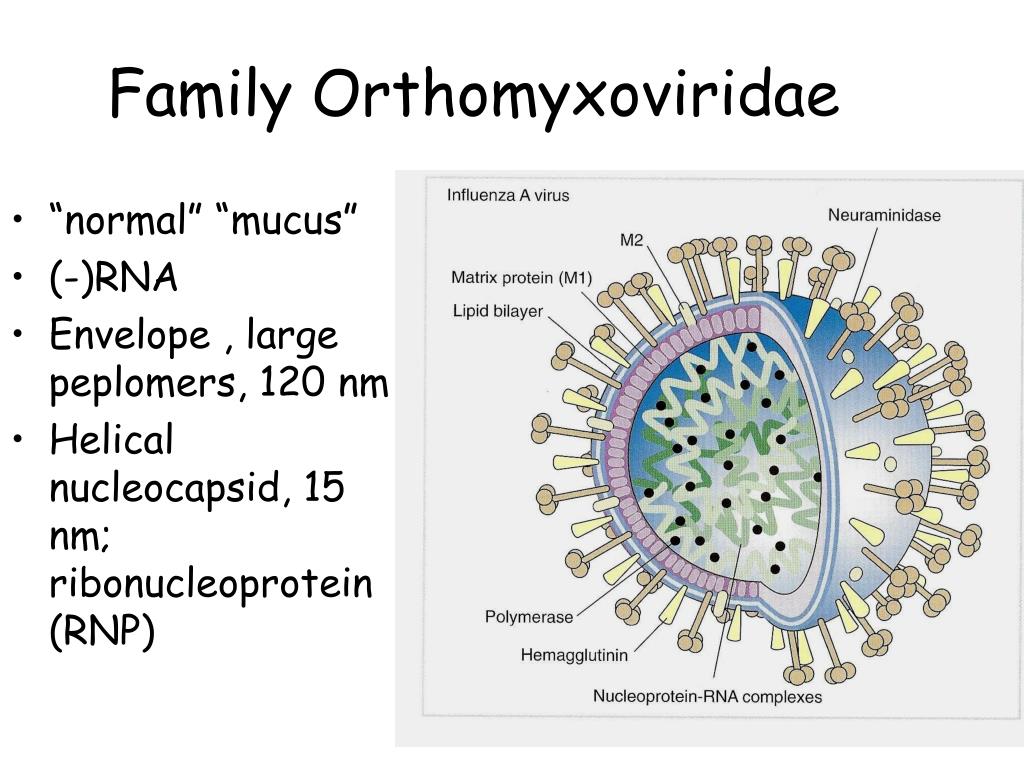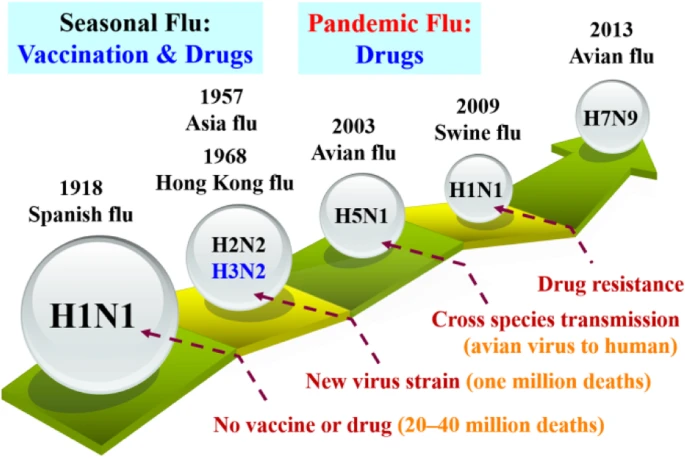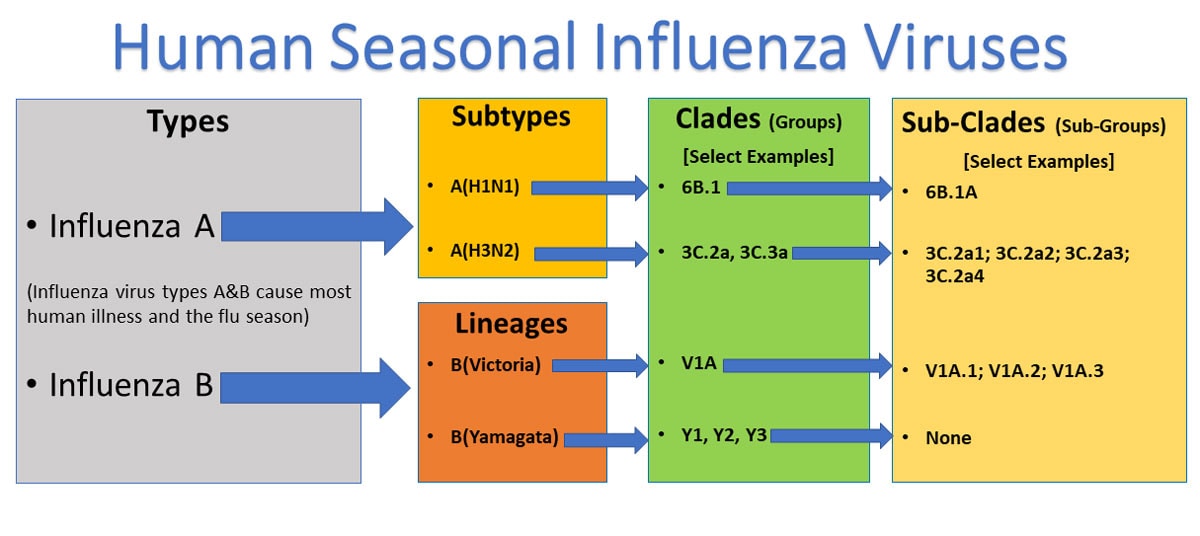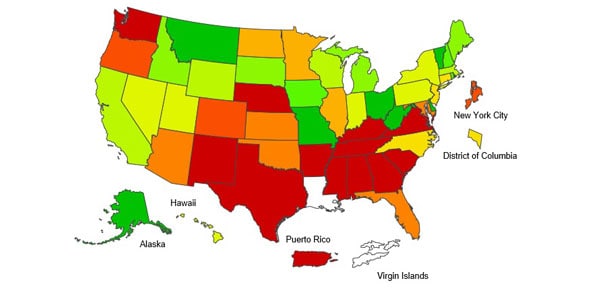Flu Season 2018-2019: the first wave
Sat, Dec 21, 2019
Influenza viruses are negative-sense single stranded RNA viruses of the Orthomyxoviridae family.
There are four types of influenza viruses: A, B, C and D. In electron microscopy these types, especially
A and
B,
could be virtually indistinguishable. D is more similar to
C.

Most of these viruses look like small spheres with spikes, although some could be irregularly shaped. Spikes are proteins and they are what's different in different forms of influenza. Typically, influenza A starts the early wave of the flu, and influenza B starts to show up at the tail-end of the season, in early spring. This year is't flu B that started the first wave while flu A may be responsible for the second wave. Is the flu shot working? It's still too early to predict.
In general, vaccines are 40-60% effective. The lowest effectiveness was always against A(H3N2) viruses: 14% for those ≥ 65 years and 21% for adults 18-49 years. Vaccine Effectiveness against A(H1N1)pdm09 was 49% for adults ≥ 65 years and 48% for adults 18-49 years, while effectiveness against B viruses was 62% for adults ≥ 65 years and 55% for adults 18-49 years. Prior vaccination status did not matter (Russel et al, 2018).
Influenza A viruses are the most common type and the most virulent. It brought many infamous pandemic outbreaks such as different forms of H1N1 that caused Spanish flu in 1918 and less virulent swine flu in 2009. Influenza A viruses can infect a wide range of birds and animals, whereas influenza B viruses infect almost exclusively humans.
2019–2020 U.S. trivalent influenza vaccines contain hemagglutinin (HA) derived from an A/Brisbane/02/2018 (H1N1)pdm09–like virus, an A/Kansas/14/2017 (H3N2)–like virus, and a B/Colorado/06/2017–like virus (Victoria lineage). Quadrivalent influenza vaccines contain HA derived from these three viruses, and a B/Phuket/3073/2013–like virus (Yamagata lineage).
Influenza vaccines’ effectiveness varies every year. The most prevalent viruses in circulation so far - B/Victoria - match the strain in both trivalent and quadruvalent vaccines. Prevalent strain in 65+ population - (H1N1)pdm09 - was also covered.
This year vaccine seems to be well matched to circulating viruses, and its effectiveness may be as high as 61% for children,
but lower than hoped for older population.
However, it could be in part because we don't have enough cases, hence not enough statistics for those 50 and older.
The season is starting, let's help each other to protect against the flu.
REFERENCES
Grohskopf LA, Alyanak E, Broder KR, Walter EB, Fry AM, Jernigan DB. Prevention and control of seasonal influenza with vaccines: recommendations of the Advisory Committee on Immunization Practices—United States, 2019–20 influenza season. MMWR Recommendations and Reports. 2019 Aug 23;68(3):1.
Russell K, Chung JR, Monto AS, Martin ET, Belongia EA, McLean HQ, Gaglani M, Murthy K, Zimmerman RK, Nowalk MP, Jackson ML. Influenza vaccine effectiveness in older adults compared with younger adults over five seasons. Vaccine. 2018 Feb 28;36(10):1272-8.
Francis ME, King ML, Kelvin AA. Back to the Future for Influenza Preimmunity—Looking Back at Influenza Virus History to Infer the Outcome of Future Infections. Viruses. 2019 Feb;11(2):122.
Palese P. Influenza: old and new threats. Nature medicine. 2004 Nov 30;10(12s):S82.

Most of these viruses look like small spheres with spikes, although some could be irregularly shaped. Spikes are proteins and they are what's different in different forms of influenza. Typically, influenza A starts the early wave of the flu, and influenza B starts to show up at the tail-end of the season, in early spring. This year is't flu B that started the first wave while flu A may be responsible for the second wave. Is the flu shot working? It's still too early to predict.
In general, vaccines are 40-60% effective. The lowest effectiveness was always against A(H3N2) viruses: 14% for those ≥ 65 years and 21% for adults 18-49 years. Vaccine Effectiveness against A(H1N1)pdm09 was 49% for adults ≥ 65 years and 48% for adults 18-49 years, while effectiveness against B viruses was 62% for adults ≥ 65 years and 55% for adults 18-49 years. Prior vaccination status did not matter (Russel et al, 2018).
Influenza A viruses are the most common type and the most virulent. It brought many infamous pandemic outbreaks such as different forms of H1N1 that caused Spanish flu in 1918 and less virulent swine flu in 2009. Influenza A viruses can infect a wide range of birds and animals, whereas influenza B viruses infect almost exclusively humans.
2019–2020 U.S. trivalent influenza vaccines contain hemagglutinin (HA) derived from an A/Brisbane/02/2018 (H1N1)pdm09–like virus, an A/Kansas/14/2017 (H3N2)–like virus, and a B/Colorado/06/2017–like virus (Victoria lineage). Quadrivalent influenza vaccines contain HA derived from these three viruses, and a B/Phuket/3073/2013–like virus (Yamagata lineage).
The season is starting, let's help each other to protect against the flu.
REFERENCES
Grohskopf LA, Alyanak E, Broder KR, Walter EB, Fry AM, Jernigan DB. Prevention and control of seasonal influenza with vaccines: recommendations of the Advisory Committee on Immunization Practices—United States, 2019–20 influenza season. MMWR Recommendations and Reports. 2019 Aug 23;68(3):1.
Russell K, Chung JR, Monto AS, Martin ET, Belongia EA, McLean HQ, Gaglani M, Murthy K, Zimmerman RK, Nowalk MP, Jackson ML. Influenza vaccine effectiveness in older adults compared with younger adults over five seasons. Vaccine. 2018 Feb 28;36(10):1272-8.
Francis ME, King ML, Kelvin AA. Back to the Future for Influenza Preimmunity—Looking Back at Influenza Virus History to Infer the Outcome of Future Infections. Viruses. 2019 Feb;11(2):122.
Palese P. Influenza: old and new threats. Nature medicine. 2004 Nov 30;10(12s):S82.



